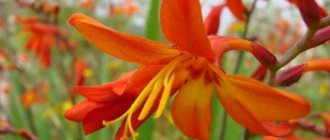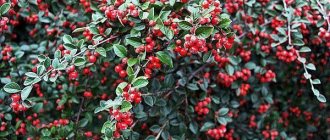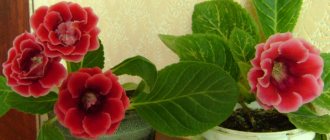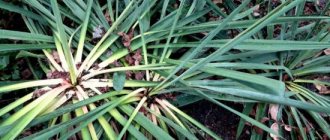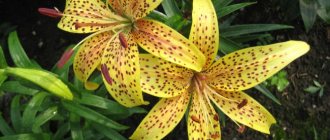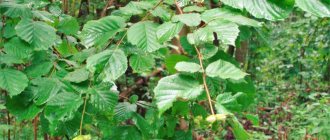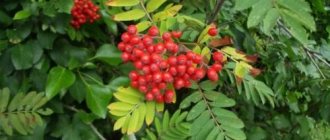Description and features
This type of hazelnut has unusual red leaves. The plant is considered quite unpretentious and can grow in any soil. The bushes have a spreading crown, large branches and dense burgundy leaves. Therefore, this type of hazel is often used for decorative purposes. You can make a beautiful hedge from it.
The plant is considered bisexual. Catkins appear on it in early spring - even before the leaves bloom. Subsequently, fruit ovaries are formed from them. In August-September they turn dark brown.
You can get up to 20 kilograms of fruit from a bush. They have excellent nutritional properties. Walnut kernels help treat pathologies of the respiratory system, heart and blood vessels. The plant is unpretentious in care. It easily tolerates heat and cold.
Composition and benefits of nuts
Hazel nuts are incredibly healthy. They contain :
- fats;
- easily digestible proteins;
- sucrose;
- B vitamins;
- vitamins of group E;
- vitamins of group C;
- iron salts
Eating hazel nuts is beneficial for both adults and children. They provide the young body with the microelements necessary for growth. In adulthood, they support heart function and brain activity . Nut kernels are eaten raw, fried, or dried. They are added to soups, roasts, desserts, and liqueurs. Walnut flour, crushed and ground nuts are widely used in cooking.
Hazel has always been famous not only for its taste, but also for its medicinal properties. :
- Fresh kernels are thoroughly ground with a small amount of water to obtain nut milk. This product is highly nutritious and is recommended for use by debilitated patients .
- Nut infusions are successfully used for diseases of the lungs, kidneys and stomach.
- Nuts ground with honey have a beneficial effect on the body’s circulatory system and relieve pain from rheumatism and gout.
- Walnut flour mixed with beaten egg yolk is an excellent remedy for heat burns.
- Walnut oil is widely used in the fight against helminths. It is also added to many moisturizing cosmetic masks and creams.
- Nut infusions significantly strengthen the immune system and increase hemoglobin.
- Thanks to the combination of zinc and B vitamins, hazel fruits are used to increase potency , stimulate spermatogenesis and normalize the functioning of the pelvic organs.
- Nuts have lactogenic properties and help increase the milk supply of nursing women.
- Hazel nut extract increases the tone of the central nervous system and normalizes intestinal activity.
- Vitamin E contained in nuts helps cope with sore throats and colds .
Advantages and disadvantages of hazel
This type of hazelnut has undeniable advantages:
- spherical crown and red leaves - thanks to this, the bushes are actively used in landscape design;
- beneficial properties of fruits - nuts include many proteins and various microelements;
- ease of care;
- resistance to temperature fluctuations.
The main disadvantage of the plant is the insufficient development of the root system, which creates difficulties with reproduction.
Red-leaved hazelnut: photo, planting and care, use in landscape design
Hazel is a genus of shrubs from the Birch family. Many representatives of this genus are cultivated as nut-bearing plants; Among them is Red-leaved hazel. More details about its breeding are described below.
General information about the plant
Red-leaved hazel, or, as people are accustomed to calling it, hazelnut, is a deciduous shrub with a maximum height of 700 cm (usually 300–500 cm). Its crown is ovoid or spherical, often reaching 6 meters in girth.
The bush can consist of 9 trunks. Their bark is ash-gray and smooth; if the shoot is young, then it is dark red. The leaves are large, oblong or round, with teeth along the contour. In spring they are dark brown with a slight green tint, in summer they are burgundy, in autumn they are dark orange.
The bottom of the leaf blade is lighter than the top.
The flowering period occurs in March, when the bush is still without leaves. Female flowers bloom separately from male flowers. The first are in the form of buds, forming inflorescences, the second are like earrings on a birch tree, but pink in color. The fruits are ready for harvest in August - September.
They are oblong in shape, in a gray-brown strong shell. One cutting holds 6–8 pieces. The core is round, dark beige. Fruiting from 4-5 years. The tree bears a harvest every year, but its quantity varies.
The Red Leaf Hazel lives, like the Common Hazel, 50–80 years.
In the description of Red-leaved hazel, it should be mentioned that the species includes several varieties:
- Ekaterina - with oblong fruits of excellent taste, covered with a thin shell. Refers to dessert varieties.
- Moscow ruby is another dessert variety famous for its productivity. The bush produces about 4 kg of fruit. It is distinguished by red foliage, as the name suggests.
- Isaevsky is also high-yielding and large-fruited. Resistant to severe frosts.
- Masha - has the characteristics of the previous plant, but the fruits are elongated and medium in size.
- Sirena - with large fruits, high yielding. It has a lush, spreading crown. Tastes great.
Rules for planting and propagation
General rules for planting hazel, which do not depend on the method of its propagation:
- Planting work can be carried out both in the spring, before the start of sap flow, and in the fall, before the onset of cold weather.
- You need to choose a site for planting that is lit, but moderately, and protected from drafts.
- It is not advisable to plant shrubs where melt water accumulates.
- The bed should be located away from tall trees (5 m).
- The soil can be any kind, but not heavy or poor. Be sure to dig up the soil before planting.
- It is advisable to prepare the planting hole a month in advance so that the soil settles and compacts. The pit should be filled with a mixture of wood ash and manure.
- Before planting, the roots are cut to 25–35 cm and left in the manure-clay mixture for a couple of hours.
Important! In order for hazel to bear fruit better, it is advisable to plant several bushes nearby. This will ensure good cross-pollination.
Features of care
Plant care must be of high quality and timely - only then can you expect a generous harvest. One should not think that if the fruit of a walnut tree is reliably protected from the environment, the plant itself is also exceptionally hardy. Hazel needs watering, fertilizing and other procedures that meet its needs.
Loosening and mulching
In the summer season, you need to spend a little time loosening the soil around the bush. The fluffing should be done carefully and not deeply, since the root system is located near the surface. Loosening is enough several times a month.
Source: https://fermer.blog/bok/sad/orehi/funduk/vyraschivanie-i-uhod-za-fundukom/12676-krasnolistnyj-funduk.html
Popular types and varieties
Today, a large number of varieties of red-leaved hazel are known. They are used not only for harvesting, but also for decorative purposes.
Lambert
The culture was developed in Holland. It is a small bush 4 meters high, dotted with red leaves. Hazelnuts begin to bloom in February. The culture tolerates frost normally. The fruits are small in size and weigh only 2 grams. At the same time, they have excellent taste. The harvest is harvested in mid-August.
Contorta
This plant variety is considered the most unusual. It is characterized by long, arching branches and wrinkled foliage. The branches are densely dotted with pink-red catkins. Under natural conditions, the culture grows in the Caucasus, Crimea, and Western Europe. This is a low bush, no more than 3 meters in height. The width of the crown reaches 2-3 meters. After planting, the culture quickly adapts and develops well.
Varshavskaya
This variety was bred in Warsaw. It is a fairly tall plant, reaching 7 meters. The culture is characterized by a lush spreading crown with a diameter of up to 6 meters.
The leaves are large in size and reddish-brown in spring. The foliage turns green in summer and orange in fall. This is a rather fastidious crop, which is sensitive to frost and excessive soil moisture. Hazelnuts ripen in early autumn and have medium-sized fruits.
Siren
This variety was bred in Poland. It is a low bush measuring 4-5 meters. Once planted, it grows quickly. Hazel is decorated with large oval leaves that have a dark red tint.
In spring, the shoots are decorated with gray catkins. After blooming, they acquire a bright red color. Hazel fruiting begins at the end of summer. The fruits are large.
Purple
This type of hazel is called purpurea. It is a hybrid variety that has excellent resistance to frost and drought. Fruit ripening occurs in August-September. The bush is of medium size and reaches 3.5 meters in height. The fruits are small in size and weigh 1.5 grams.
Ordinary
Common hazel is considered a fairly popular plant. It is a bush that grows up to 4-6 meters in height. It is characterized by large red-brown leaves. They may also have a dark purple color. The lower part is covered with lighter fluff than the upper part. By autumn the foliage turns green.
See also
Diseases and pests of walnuts, why they don’t bear fruit and methods of treatment
Read
Red leaf hazel
Red-leaved hazel is vulnerable in the winter and requires more careful attention when planting and caring. To ensure annual fruiting, mutually pollinating varieties of hazel are planted on the plots. The Tambov early and Pervenets varieties are pollinators of red-leaved shrubs. They form many winter-hardy male inflorescences and contribute to the preservation of high yields. In winter, hazel pollen often dies, but female flowers are preserved and pollinated by male flowers of pollinating varieties. Breeders have developed some varieties that can survive in cold winter - Pushkinsky Red and Maria Markevich.
How to plant correctly
To achieve success in growing crops, it is necessary to ensure proper planting work. Preparation of seedlings and compliance with deadlines are of no small importance.
Recommendations for choosing deadlines
It is allowed to plant the bush in open ground in the spring, before the sap begins to flow. This can also be done in the fall. In the second case, it is recommended to carry out planting work 3-4 weeks before the first frost. Thanks to this, they will have time to take root and adapt to new conditions.
Selection and preparation of planting material
To grow a crop, you will need several seedlings that differ in their ripening period. This will ensure normal pollination of plants. Seedlings should have a small number of leaves and well-developed roots. It is desirable that their length be at least 30 centimeters.
When choosing a plant, you should make sure that it has more than 3 shoots. It is also worth inspecting the crop and making sure there is no damage or symptoms of rotting.
Before planting, seedlings should be trimmed to 30-35 centimeters. It is recommended to soak the root system in a growth stimulator.
Location requirements
To get a good harvest, you need to plant several hazel bushes nearby. For this plant, you should choose an open area that is well lit by the sun and not blown by the wind.
Soil and site preparation
1 month before planting, it is worth making a deepening. During this period, the earth will settle and compact. The dimensions of the hole must be at least 70x70 centimeters. A bucket of humus should be poured into the bottom of the hole. It is also recommended to add a glass of superphosphate and 50 grams of potassium sulfate.
Planting scheme
To improve the survival rate and rooting of hazel, certain rules should be followed when planting. The distance between plants should be 3-5 meters. In this case, it is necessary to choose a place that is not flooded by spring floods.
To carry out the landing, do the following:
- It is recommended to pour a mound of earth into the central part of the hole so that the hazel takes root.
- Remove the roots from the solution, straighten them and place them in the center of the hill.
- Fix the shoots vertically and tie them to a wooden peg. It must be installed in the hole.
- Sprinkle the roots with loose soil and trample lightly.
- Leave the root collar 5 centimeters above the ground level.
- Water the seedling with 3 buckets of water.
To speed up the rooting of the crop, it is recommended to mix the planting soil with forest soil. It is recommended to take it from the rhizome of wild hazelnut.
Planting hazelnuts
- Soil selection. In general, hazel is suitable for all types of fertile soil, as long as it is not waterlogged or dry. A big plus will be the drainage of the soil (solid content of sand and stones).
- Site selection. This can be either a well-lit or slightly shaded part of the yard - in the dense shade fewer nuts will grow. Make sure it is not a windy place. Even if you get a frost-resistant variety, do not “settle” it on the northern slope - it is better to choose a north-eastern or eastern corner for the bush.
- Neighbours. Hazelnuts need dust-collecting companions. Even if your bush pollinates itself, in the presence of a companion, cross-wind pollination occurs, which qualitatively affects the number of fruits set. Such bushes should be planted in one row.
- Ideal time to disembark. Hazelnuts are planted both in autumn and spring. But experienced gardeners advise planting it in mid-September.
If you are planting several hazelnut bushes, the distance between them will differ depending on the purpose for which you bought them. Do you just want to decorate the yard or make a semblance of a hedge? Leave 3-4 meters between bushes. Did you buy hazelnuts for their fruit? Increase the distance between seedlings to 5-6 meters.
Planting hazel step by step
- Dig a hole 60x70 cm.
- Place more humus on the bottom. In general, one plant requires about 12 kg. This fertilizer can be flavored with superphosphate and potassium salt.
- If you already have hazelnuts growing on your site, collect some soil near its roots and send it to the planting hole for the new plant. Why is this being done? Near the roots, hazelnuts form specific fungal mycoses. If they are in the ground, the seedling planted in it will take root faster.
- Trim the seedling to 25-35 cm. Before planting, its roots should be kept in a mixture of clay and humus.
- After planting, place a wooden support next to the plant and tie the hazel to it.
- Water young hazel often. After each watering, slightly loosen the soil, this will allow the plant to take root faster.
Plant formation
Hazelnuts can grow in the form of a tree or a bush - it all depends on your desire.
In any case, hazel needs to be shaped every 6-9 years. It is done in the fall. All old, broken, diseased and underdeveloped branches are removed, and the cuts are covered with garden varnish.
If you want a bush, leave 7-10 powerful trunks (it is important that they do not stick out only to the left or right, but extend evenly from the root). For the tree, leave 1 of the strongest trunks, from which skeletal branches will “scatter”.
You will learn about what crown shape you should choose from this video:
And here you will see a successful tree shaping using the example of the Ekaterina variety:
Tree care
Watering. Even drought-resistant varieties need regular watering. Do it early in the morning or late in the evening. For this purpose, it is advisable to use water not immediately from the well. Pour it into a large vat in advance, allowing it to warm up in the sun, and then spread it around with a watering can.
Nutrition. In this regard, hazelnuts are not too gluttonous. Once a year it can be pampered with mineral fertilizer, and once every 3-4 years with organic fertilizer. And when the bush is about to begin to set fruit, you can give it urea.
Harvesting
The fruits ripen from August to September.
Nuts appear on the bush every year, but with varying success - one year the harvest can be very plentiful, the second - meager.
What can I do to make the plant bear more fruit? Watch and remember:
Rules of care
To ensure normal development and reap a bountiful harvest, it is recommended to properly care for the plant.
Watering mode
The culture needs moist soil, but excess liquid is contraindicated for it. After planting and watering, it is recommended to cover the ground with a mulch layer. After 1 week, watering must be repeated. It is important to ensure that the moisture is completely absorbed. It is necessary to avoid stagnation of liquid near the shoots and rotting of the roots.
In summer, it is recommended to water the plant 2-3 times a month. 1 bush requires 10 liters of water. It is important to ensure that the roots do not dry out in June and July. During this period, fruits are formed.
Top dressing
It is recommended to apply fertilizers after planting a maximum of once every 3 years. For this, compost and humus are used. 1 crop will require 5 kilograms of product. At the beginning of summer, nitrogen agents are used to increase yield parameters. For 1 bush use 100 grams of the product.
Trimming
It is recommended to prune the plant in late autumn, after the leaves fall. It is necessary to thin out young plants up to 4 years. This will help increase their productivity.
When carrying out autumn pruning, it is worth getting rid of dry, damaged, long branches. It is recommended to tilt the side shoots down and to the sides, and then secure them with wire. This will make it easier for the sun and air to penetrate deep into the crown.
See also
Description and characteristics of the 35 best varieties of walnuts, planting and care
Read
Loosening and weeding
In the summer, several times a month, the tree trunks are loosened. This procedure should be performed carefully, since the roots are located near the surface of the soil.
Mulching
After watering and absorbing moisture, the soil around the plant should be mulched. To do this, use mown grass and tree bark. Thanks to this, it will be possible to retain moisture in the root area. It is important that the mulch does not touch the trunk or shoots of the bush - this will lead to their rotting.
Crown formation
Starting from the central part of the crown, it is recommended to trim the hazel in such a way as to obtain the appearance of a vase. Thanks to this, the sun's rays will reach young, unformed shoots. This increases the number of ovaries.
Preparing for winter
Young plants less than 4 years old should be covered for the winter. Film or agrofibre is suitable for this purpose. Long shoots can be bent to the ground and secured with metal brackets. The top of the plant should be covered with spruce branches. When snow falls, it is recommended to throw it on a bush.
Plants older than 4 years, which are frost-resistant varieties, can withstand winter without shelter. Such cultures include the Miracle of All Saints, Maria Makarevich.
Protection from diseases and pests
Hazel is highly resistant to disease. Sometimes it is attacked by harmful insects. The plant may suffer from the activity of bud mites, scale insects, and caterpillars. Common aphids, nut weevils, and borer beetles also cause problems.
To cope with pests, Inta-vir is used. For the first time, the bush should be processed before the buds open. In the second - after the appearance of foliage.
If agrotechnical recommendations are violated, the plant may suffer from fungal infections. The use of colloidal sulfur and treatment of the crop with Bordeaux mixture will help to cope with them.
Diseases and pests
Red-leaved hazel is a disease- and pest-resistant variety. Rarely attacked by aphids, scale insects, caterpillars, and walnut weevils. To prevent the appearance of insects on hazelnut leaves, it is treated in February before the buds open with appropriate preparations. The bushes are sprayed again after the leaves appear.
Important! A dangerous pest for hazel is the borer beetle. Its females lay eggs in the fruits of the plant. Afterwards, the insects completely destroy the crop.
Red-leaved hazelnuts are susceptible to fungal diseases. To combat them, the bush is sprayed with a solution of Bordeaux mixture.
Reproduction methods
Hazel can be propagated in different ways. This allows each gardener to choose the best option.
Seeds
The use of seed material is considered the most complex and labor-intensive method of propagation. To do this, you need to select the strongest nuts and germinate them in a separate container. Then the seedlings should be transferred to the ground.
Root layering
For propagation of the crop by layering, young shoots are used. It is recommended to bend the cuttings towards the soil and place them in a ditch. The end of the branch should be fixed and sprinkled with soil. This will help form new shoots.
By shoots
The easiest way to propagate a crop is to divide the bush. To do this, you need to separate the plant containing 2-3 shoots. Make small cuts at a distance of 15-20 centimeters. This will help form new branches.
Cuttings
To do this, you need to take strong and healthy cuttings from bushes that are 2 years old and place them in containers based on peat and sand. Constant watering will help the shoots grow their own roots.
How does this species reproduce?
Layerings
- In the spring, when there is no foliage yet, select several young one-year-old shoots.
- Dig a groove next to each one, as shown in the photo. Its depth should be about 20 cm.
- Bend the branch into the groove and secure it with pegs. Sprinkle it with earth, water it well (it is better if the water is not iced, but heated).
- After about a month, the buds on this branch will begin to sprout into shoots.
- Somewhere in June, shoots that have sprouted from the ground (they should grow to at least 15 cm) need to be hilled up to 2/3 of the height. Repeat this procedure several more times until the end of summer.
- Divide these shoots and transplant them to a permanent place of “residence”.
A successful example of working with a bush is shown in this video:
Seeds
Fully ripe nuts (the healthiest, largest ones) need to be planted in nutritious, humus-rich, watered soil. This can be done both in spring and autumn.
- The seed is deepened by 3 cm. If it is a common box or bed on the street, leave 10 cm between the nuts, so that the row spacing is 20 cm.
- Sprinkle the “guys” with a mixture of peat and humus. In the fall, additionally insulate the planting with hay or sawdust.
- Allow the seeds to germinate for 2 years.
- Dig up the seedlings and transplant them to a permanent place.
Important! With such propagation, hazel may not convey varietal characteristics. So it is better to propagate rare or simply successful hazelnut varieties only by vegetative methods.
Dividing the bush
When dividing a dug-out bush, make sure that each division remains with roots at least 20 cm long (preferably longer).
The delenki are planted in a permanent place and are well watered with warm water.
Cuttings
This is a rather controversial method, since hazel cuttings take root “with a creak.”
You will get more or less successful results if:
- you will use only two-year-old branches;
- cut them early in the morning;
- for rooting you will use sand + peat;
- You will root the cuttings in a cozy (protected from drafts) place, without direct sunlight, with frequent watering (you can also lightly spray the planting material).
Hazelnut grafting - does this method work?
On YouTube you can often see reviews of bloggers advertising hazel branches as a scion. True, the gardeners I respect are not sure that hazel is a plant worth grafting. It is better to buy a ready-made varietal bush and plant it at home.
An experienced gardener will tell you more about the mistakes that beginning hazelnut lovers make:
Hazel (Hazelnut): description of hazel
Hazel, or hazel , is a deciduous tree (shrub) of the Birch family, growing up to 10 meters.
It has an ovoid, flat or spherical crown. The bark of the tree is gray-brown, dissected with transverse stripes. The root system is powerful and superficial. The leaves of the hazel tree are matte, dark green, pointed, rounded, and ovate.
Did you know? Popularly, hazel is called hazel or hazel, but hazelnut, which is common in cultivation, is a completely different plant. Hazelnuts and hazel
-
related trees, representatives of the same family.
Hazelnuts (or as they are also called “hazelnuts”) begin to bloom in early spring (March-April), even before the leaves bloom. During this period, golden earrings appear on the tree. Since hazel is a monoecious plant, both catkins and pistillate flowers are located on the same tree or bush. The hazel flower consists of bifurcated stamens. The hazel tree begins to bear fruit in the seventh or eighth year of life and produces a harvest every year. The fruits are small (2 cm), represented by oval or spherical nuts enclosed in a light green plus. Each inflorescence can contain up to 30 fruits, although 3-4 are usually found. Ripen in August. The hazel tree propagates by layering, seeds or root suckers.
Today, more than 100 varieties of hazelnuts are known, the most popular of which is Panaches. Its fruits have a pleasant taste and are characterized by a high fat content (62-65%!). Moreover, this variety produces a bountiful harvest every year and does not require pollination.
Hazel lives in broad-leaved, coniferous and mixed forests, and in those places where common hazel grows, it forms dense thickets, growing intensively in clearings and pastures. Widely distributed in the Caucasus, Middle East and Europe. It prefers fresh, fertile and moist soil, therefore, it is usually found at the bottom of ravines, along rivers, streams, in the steppe and forest-steppe. It practically does not grow on poor, swampy, acidic, peaty soils.
However, tasty and healthy nuts can be tasted not only in forests - this tree has long been cultivated. It is quite possible to obtain a hazel harvest from your garden plots if you know the intricacies of caring for and growing this plant.
Growing raspberries in a personal plot: useful tips


